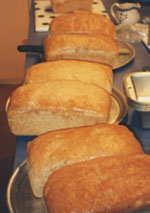Breadmaking
 |

For additional recipes, click here.
The "golden rule of homemade bread: it will always be a hit no matter how it turns out." From The Bread Baker's Apprentice by Peter Reinhart, a master teacher of professional bakers.
10 Good Reasons to Learn How to Make Bread
- Fresh warm bread is delicious and healthy.
- Breadmaking is enjoyable and reduces stress.
- Making bread leads to a feeling of accomplishment.
- Serving homemade bread to guests is a wonderful treat that everyone appreciates.
- Breadmaking is a great family activity.
- Breadmaking connects us with something real and essential.
- Making bread develops an appreciation for process.
- Breadmaking develops patience and creativity.
- Learning about bread leads to an appreciation of different cultures.
- Breaking bread together builds community.
   |
Breadmaking Made Simple
For all the reasons listed above, we encourage you to try to make bread at home. While some breads require extensive preparation and pose difficulties for the occasional home baker, there are many kinds of bread that are relatively easy to prepare at home. For those who have never baked bread before we suggest that you start with something basic like the whole wheat loaf recipe contained on this web site. We've used this recipe quite successfully in hundreds of workshops in the schools. Once you've had success with this basic recipe you will have more confidence to explore the vast and varied world of breadmaking!
An Outline of the Basic Steps for Raised Bread |
Most of the breads we eat in the United States are raised or leavened breads that use the fascinating ingredient called yeast to make the dough rise (see The Staff of Life). The following outline of the steps involved in making these breads can serve as an aid in understanding the breadmaking process:
|
As you can see, the process is fairly simple. Most of the work is done in step #1 with a little more done at step #3. Breadmaking does take time, however. While the most time-consuming steps - 2, 4, and 5 - don't involve any work, they do require some patience and vigilance on the part of the baker. Go ahead, give it a try!